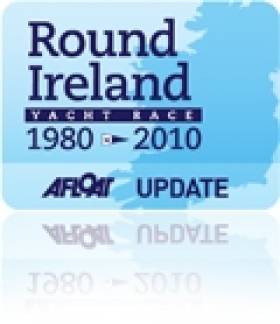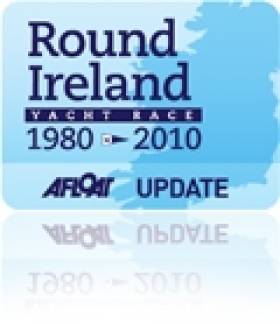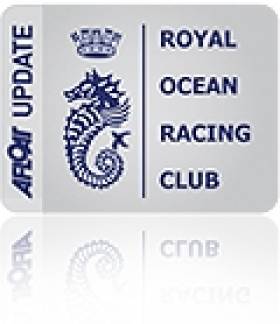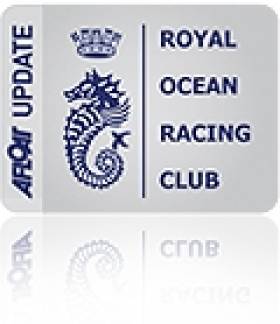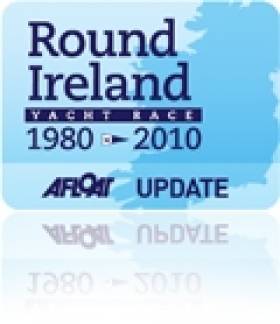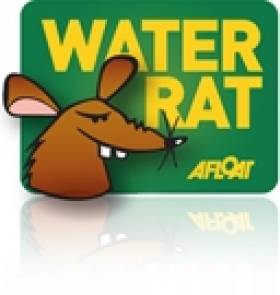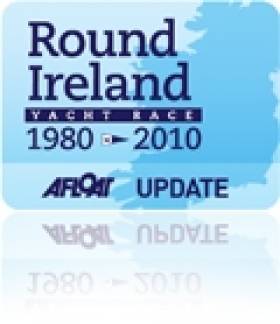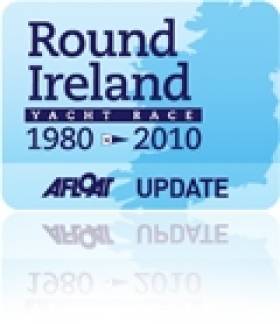Displaying items by tag: Round Ireland
Liddy Launches La Solitaire du Figaro Campaign (Podcast)
Mick Liddy is already picturing the magical scene of the international Figaro fleet inside Dun Laoghaire's harbour next August. He's one of Ireland's top offshore sailors but before Liddy can join the 55 boat fleet he has two months to raise the necessary campaign funds. It's a tall order but the 33-year old Dun Laoghaire helmsman is undaunted by the short time frame and insists that although 'the challenge is big, the opportunity is bigger'. Listen into the podcast here:
Today's Irish Times Piece on Liddy's Campaign HERE
Liddy's Figaro Facebook Page HERE
Figaro Race start images from Kinsale by Bob Bateman HERE
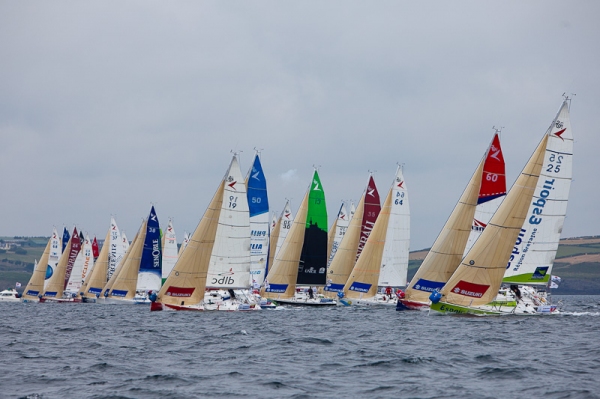
The Figaro fleet depart Kinsale in August. Photo: Bob Bateman
Preparing for La Solitaire du Figaro here
Latest news for La Solitaire du Figaro hereThe 'Home of the Round Ireland' Celebrates 60
Wicklow Sailing Club's 60th Anniversary Dinner Dance will be held in the Grand Hotel, Wicklow at 8pm on Saturday the 20th of November. Fred Drew will be mounting a one off Historical Display of the Club's major events, which will feature the staging of the Round Ireland race. Contact Kerrie 0404 67526 or [email protected] for more information or to reserve tickets. Tickets are €50pp.
For a look back over a recent history of the race read Afloat's Round Ireland Yacht Race review
Round Ireland Remembered: Saturday Night is Vroon Night
Round Ireland Champ Piet Vroon from Holland is in Wicklow town for Saturday night's celebration of the 30th Round Ireland. Vroon, 80, who has already picked up the Royal Ocean Racing Club's Yacht of the Year award is back in Wicklow and it is certain exploits during Ireland's offshore race in July will be relived when Vroon lifts the Round Ireland trophy at the Park Hotel in Newtownmountkennedy. The Wicklow Sailing Club prize giving includes a new Irish Cruiser Racing Association trophy (ICRA) and the inaugural winner is a local boat, Aquelina (The Tyrrell fmaily) from Arklow.
Among the attendance at the offshore night of the year is 19 crew from visiting UK competitor Malta Puma.
More on the Round Ireland Yacht Race:
Round Ireland Yacht Race 2010 Review
Round Ireland Yacht Race, Ireland's top offshore fixture
A Round up of 80 stories on the 2010 Round Ireland Yacht Race
Round Ireland Winner is RORC's Yacht of the Year
The Royal Ocean Racing Club in London announced that Holland's Piet Vroon's Ker 46 Tonnerre de Breskens 3 is the 2010 Yacht of the Year.
Piet has been racing with the RORC for 50 years and during that time has achieved many notable successes including winning the Rolex Fastnet Race. Now 80 years young, he competed in eight RORC races this season including the Conway Media Wicklow's Round Ireland and the Sevenstar Round Britain and Ireland Race.
Tonnerre de Breskens 3 takes the Jazz Trophy for the overall winner of the Season's Points Championship (when all races count); the Trenchemer Cup for winning IRC Zero; the Stradivarius Trophy for the best overseas yacht in IRC and also the Somerset Memorial Trophy for outstanding racing achievement by a yacht owned or sailed by a RORC member as voted for by the Main Committee. It was a spectacular season from a veteran campaigner and great supporter of RORC racing.
Niklas Zenstrom's JV72, Rán 2, was awarded the Dennis P Miller Memorial Trophy for a British Yacht Overseas. Rán travelled all over the world and has an impressive list of victories which included the Mini-Maxi Rolex World Championships, winning her divisions in the 2009 Rolex Sydney Hobart Race; Antigua Sailing Week; Newport Bermuda Race; Onion Patch Series and Copa del Rey.
Also of note are the team on British Soldier who were second overall in the Season's Points Championships and won the Serendip Trophy for the best series produced yacht in IRC. The boat provides much needed 'R and R' for war veterans and through the Toe in the Water tri-services initiative, introduces many disabled servicemen to sailing.
A full list of all the RORC trophy and award winners:
RORC Annual Challenge Trophies and Special Awards
2010 YACHT OF THE YEAR - TONNERRE DE BRESKENS 3 (KER 46) PIET VROON
Winning the SOMERSET MEMORIAL TROPHY
For outstanding racing achievement by a yacht owned or sailed by a RORC member as voted for by the Main Committee.
In recognition of not only winning IRC Overall by a huge margin, but in particular for supporting and winning RORC races for over 50 years.
ASSUAGE TROPHY - FOGGY DEW (JPK 10.10) NOEL RACINE
CHAMPIONSHIP FOR RORC MEMBERS
For the yacht with the most points in IRC overall in the Cherbourg Race plus her best three races taken from Cervantes, Morgan Cup, Myth of Malham and Cowes-Dinard-St. Malo races
ALAN PAUL TROPHY - BRITISH SOLDIER (A 40) ARMY SAILING ASSOCIATION, LT COL TIM HILL
For consistent high performance in IRC. Based on consistent high scores plus a bonus for number of races completed.
Class Championship Tropies
| IRC Overall | Jazz Trophy | Tonnerre de Breskens 3 (Ker 46) | Piet Vroon |
|---|---|---|---|
| IRC Super Zero | Europeans Trophy | John Merricks II (TP 52) | British Keelboat Academy |
| IRC Zero | Trenchemer Cup | Tonnerre de Breskens 3 (Ker 46) | Piet Vroon |
| IRC One | Emily Verger Plate | Visit Malta Puma (Reflex 38) | Sailing Logic, Philippe Falle |
| IRC Two | Grenade Goblet | Foggy Dew (JPK 10.10) | Noel Racine |
| IRC Three | Cowland Trophy | Iromiguy (Nicholson 33) | Jean Yves Chateau |
| Two-Handed Division | Psipsina Trophy | Psipsina (HOD 35) | John Loden & Patrick Cronin |
| David Fayle Memorial Cup | For the best Sailing School Yacht in IRC | Visit Malta Puma (Reflex 38) | Sailing Logic, Philippe Falle |
|---|---|---|---|
| Haylock Cup | For the best British Service Yacht in IRC | British Soldier (A40) | Army Sailing Association, Lt Col Tim Hill |
| Stradivarius Trophy | For the best Overseas Yacht in IRC | Tonnerre de Breskens 3 (Ker 46) | Piet Vroon |
| Serendip Trophy | For the best Series-produced Yacht in IRC | British Soldier (A40) | Army Sailing Association, Lt Col Tim Hill |
Special Awards
| Freddie Morgan Cup | For a Classic Yacht in IRC | Winsome (S&S 41) | Harry Heijst |
|---|---|---|---|
| Dennis P Miller Memorial Trophy | For a British Yacht Overseas | Rán 2 (JV 72) | Niklas Zennström |
| Arambalza Swan Cup | For the highest scoring Swan in the race season | Selene (Swan 44) | Adrian Lower |
| Peter Harrison Youth Trophy | John Merricks II (TP 52) | British Keelboat Academy | |
| Duncan Munro-Kerr Youth Challenge Trophy | For the youngest crew member on board a yacht which on Season's Points finishes in the top three of her IRC Class |
Floris R. W. Oud sailing on Winsome | |
| Red Funnel Prix D'Elegance | Antix (Ker 39) | Anthony O'Leary | |
| RORC Salver | Morgan Cup Race - First Yacht Home | Tonnerre de Breskens 3 (Ker 46) | Piet Vroon |
2010 RORC Points Championship
RORC Medallions: Gold – 1st, Silver – 2nd, Bronze – 3rd, 4th & 5th
| IRC Super Zero | ||
|---|---|---|
| 1st | John Merricks II (TP 52) | British Keelboat Academy |
| IRC Zero | ||
| 1st | Tonnerre de Breskens 3 (Ker 46) | Piet Vroon |
| 2nd | John B (Grand Soleil 54) | Charles Ivill |
| 3rd | Erivale III (Ker 39) | Mike Greville |
| IRC One | ||
| 1st | Visit Malta Puma (Reflex 38) | Sailing Logic, Philippe Falle |
| 2nd | British Soldier (A 40) | Army Sailing Association, Lt Col Tim Hill |
| 3rd | Coup de Coeur (First 40) | Marc de Saint Denis & Géry Trentesaux |
| IRC Two | ||
| 1st | Foggy Dew (JPK 10.10) | Noel Racine |
| 2nd | Psipsina (HOD 35) | John Loden & Patrick Cronin |
| 3rd | Winsome (S&S 41) | Harry Heijst |
| IRC Three | ||
| 1st | Iromiguy (Nicholson 33) | Jean Yves Chateau |
| 2nd | Ultreia! (JPK 9.60) | Matthias Kracht |
| 3rd | Pyxis (X 332) | Kirsteen Donaldson & Judith Eastwood |
| Two-Handed Division | ||
| 1st | Psipsina (HOD 35) | John Loden & Patrick Cronin |
| 2nd | Solan Goose of Hamble (A 35) | Peter Olden |
| 3rd | Diablo-J (J 105) | Nick Martin |
| Class 40 Division | ||
| 1st | Concise 2 | Ned Collier Wakefield |
| 2nd | Orca | Tom Hayhoe & Natalie Jobling |
| 3rd | Merena | Alexis Guillaume |
| IRC Overall |
||
|---|---|---|
| 1st | Tonnerre de Breskens 3 (Ker 46) | Piet Vroon |
| 2nd | British Soldier (A 40) | Army Sailing Association, Lt Col Tim Hill |
| 3rd | Visit Malta Puma (Reflex 38) | Sailing Logic, Philippe Falle |
| 4th | Psipsina (HOD 35) | John Loden & Patrick Cronin |
| 5th | John Merricks II (TP 52) | British Keelboat Academy |
| Assuage Tankards |
||
|---|---|---|
| Cervantes Trophy Race | Visit Malta Puma (Reflex 38) | Sailing Logic, Philippe Falle |
| Myth of Malham Race | Tonnerre de Breskens 3 (Ker 46) | Piet Vroon |
| Morgan Cup Race | Psipsina (HOD 35) | John Loden & Patrick Cronin |
| Cowes-Dinard-St. Malo Race | John Merricks II (TP 52) | British Keelboat Academy |
Kinsale Teenagers Go Offshore on Mercy Mission
The keen sailors, most of whom have just finished their exams, will be sailing a 39ft yacht round the coast of Ireland over six days in August, to raise money for the international charity, Mercy Ships. The charity provides free medical and humanitarian aid to the poorest countries in Africa via its 500ft hospital ship, the Africa Mercy. It is the first time any of the youngsters have undertaken such a challenge and their training starts this week at the Kinsale Yacht Club, where they will familiarise themselves with the yacht Sonas kindly supplied to them for the challenge by its owner David Ross
Ben Fusco, 19, from Kinsale, said, "We are all keen sailors and wanted to combine our love of sailing with doing something for charity. There are lots of great maritime related charities out there but when we heard about the work of Mercy Ships, we were taken by the idea that a ship provides free medical care to some of the poorest people in the world.
"Hearing that thousands of people every year are given free medical care by volunteers on the ship was inspiring and we knew we had to do something special to raise money for them – hence our Round Ireland Challenge.
More on the forum thread started by Ben Fusco HERE.
Biggest fleet of the Year Bound for St. Malo
The 164 mile race to St. Malo from Cowes has always been popular and with 123 boats already in, it is the biggest entry for a RORC offshore race so far this season. Unfortunately a glance at the entry list reveals there are no Irish entires to date but the size of this fleet reflects the potential Interest in offshore sailing, a shot in the arm for organisers of Irish offshore fixtures if UK and French fleets are targeted.
Mike Slade's Farr 100 Maxi, ICAP Leopard, will be hot favourite for line honours for this weekend's race to St. Malo and make no mistake; the world record breaking yacht will be attempting to break their own course record, set in 2008.
"We have held the record in four different boats, Ocean Leopard took about 19 hours, in Longabarda we took about 16 hours, Leopard of London about 15 hours and racing ICAP Leopard we got it down to about 11 hours. We will be hoping to get a good westerly wind so that we can lay the Casquets and then charge off towards St.Malo under spinnaker.
I have been doing this race for about 20 years and we are running out of restaurants that will have us! Hopefully we will be in by Saturday morning and have an enormous celebration!" commented Mike Slade.
There are sixteen RORC trophies up for grabs and there will be some intense battles right through the fleet. Four Class 40s will also be racing including World Champion, Concise, skippered by young aspiring yachtsman Tom Gall.
No less than nine A 35s will undoubtedly be swapping tacks throughout the race, including French Rolex Commodores' Cup representative, Marc Alperovitch and Jerome Huillard's, Prime Time. However, last year's IRC Two winners Franck-Yves Esco-Voiles' A 35, Ame-Hasle, will certainly be looking to retain the Yacht Club de Dinard Trophy.
Twenty six Beneteau yachts will be racing, many from France but also making the trip to St. Malo is RORC Commodore Andrew McIrvine, who will be racing his First 40, La Réponse, against three other sister ships.
Andrew McIrvine commented: "La Réponse is a new boat and a new design, so we are getting used to it and the new sails, there are a lot of tweaks to be done but we are learning more every race. It is the first boat that I have had with a fridge which is a bit of a novelty for me! So far we are pretty happy with the boat speed but there is more to come, I am sure."
Hugues Riché's Grand Soleil 44R, Spineck, was the overall winner of the prestigious King Edward VII Cup for best yacht overall in IRC. Riché has strong associations with the Yacht Club de France and after winning last year, he let the Club put the Cup on display. Spineck is back again this year and will be highly motivated to retain it.
Cowes – Dinard – St Malo Race
Organised by the Royal Ocean Racing Club in association with UNCL, Yacht Club de Dinard, Société Nautique de la Baie de St. Malo and the Royal Yacht Squadron.
Start: Friday 2nd July from the RYS, to the West.
First warning signal: 1450
Course: Cowes – Casquets - Les Hanois – St Malo. Approx. 164 miles.
Full details including on-line entry at www.rorc.org
Exactly one week after it left Wicklow, Yahttzee, the last competitor in the Round Ireland Yacht Race 2010 arrived home this morning allowing Wicklow Sailing club to publish its full overall results table (attached below). It will be a race that will be remembered for its predominantly light winds. Full Round Ireland Yacht Race overall and class results are attached below in our download section, showing the magnificent performance of overall winner Tonnerre de Breskens from Holland.
More on the Round Ireland Yacht Race:
Round Ireland Yacht Race 2010 Review
Round Ireland Yacht Race, Ireland's top offshore fixture
A Round up of 80 stories on the 2010 Round Ireland Yacht RaceFrance v Holland in tomorrow's Round Ireland Final?
Round Ireland 2010 is half over but only just begun. Winds–as usual–are forecast to be varied on the next leg down the East coast. Experienced Round Ireland pundits say it's too early for predictions. Read this morning's analysis here. Others though have stuck their necks out to give Dutch yacht Tonnerre de Bresekens the trophy already. Read our forum thread here. Water Rat still pins his hopes on a great French win, Inis Mor is the boat to beat! Read his thoughts here. Check our weather podcast here for today and tomorrow. Is 2010 really the predicted small boat race or will this instead be a France v Holland final? We'd like your views on our forum here.
More on the Round Ireland Yacht Race:
Round Ireland Yacht Race 2010 Review
Round Ireland Yacht Race, Ireland's top offshore fixture
A Round up of 80 stories on the 2010 Round Ireland Yacht RacePodcast: Strong Winds on Wednesday Morning
Up to 30 knot winds will sweep the Round Ireland fleet up the west coast for a time tomorrow morning. This latest wind news (and much more) is in weather guru, Mike Broughton's latest weather observations in the podcast below. The fleet head for the north coast and the second half of Round Ireland 2010 tomorrow, edging closer to Inistrahull, a notorious landmark where many previous races effectively restarted. Tonnerre be warned!
Leaders Power Up the West Coast
Just over half the fleet have rounded the Fastnet Rock in the Conway Media Round Ireland Yacht Race, with the leaders stretching their legs in plenty of breeze up the west coast. With between 14 and 20 knots of wind from an average direction of 200 degrees, those that have pointed their noses north up the west coast have been able to pull away, with Tonnerre de Breskens now 40 miles clear of the nearest challenger on the water, the Open 60 Spirit of Rosslare Europort. Tonnerre is off Slyne Head, with yesterday's overall leader, Inis Mor, 55 miles behind the leader and both are heading inshore, which would seem to be the smart thing to do, keeping them in the stronger band of wind for longer.
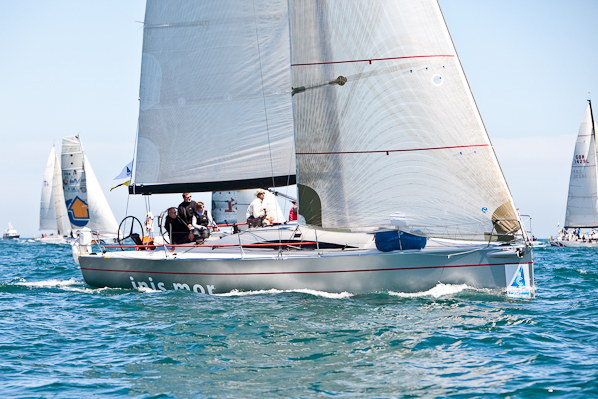
French Yacht Inis Mor is among the leaders at the halfway stage of this week's Round Ireland Race. Photo: Bob Bateman
The winds look like lightening and veering, which would mean the boats further inshore would not only be in stronger wind for longer, but when it does drop and veer, they will be on a hotter angle up the west coast than those further out.
The leader is now almost at the halfway point in terms of distance, while the boat bringing up the rear has covered approximately 25% of the total distance, a spread from top to bottom of 175 miles.
The top four are spread out over 70 miles, with fifth to eighth all within six miles of each other. From eleventh back, the fleet snakes from Dursey Island all the way back to Glandore.
Have your say on the racing in our forum thread HERE.
The race tracker is HERE, and the official site is HERE.
Results at 1500hrs yesterday are the most recent provided:
Overall 1st Inis Mor
2nd Visit Malta Puma
3rd Tonnerre de Breskens 3
IRC 0 Inis Mor
IRC 1 Visit Malta Puma
IRC 2 Psipsina
IRC 3 Alchimiste
Class 4 Cruisers Cavatina
Class 5 Classics Cavatina
Class 6 Sigma 38 Persistance
Class 7 Two Handed Daft.com





























